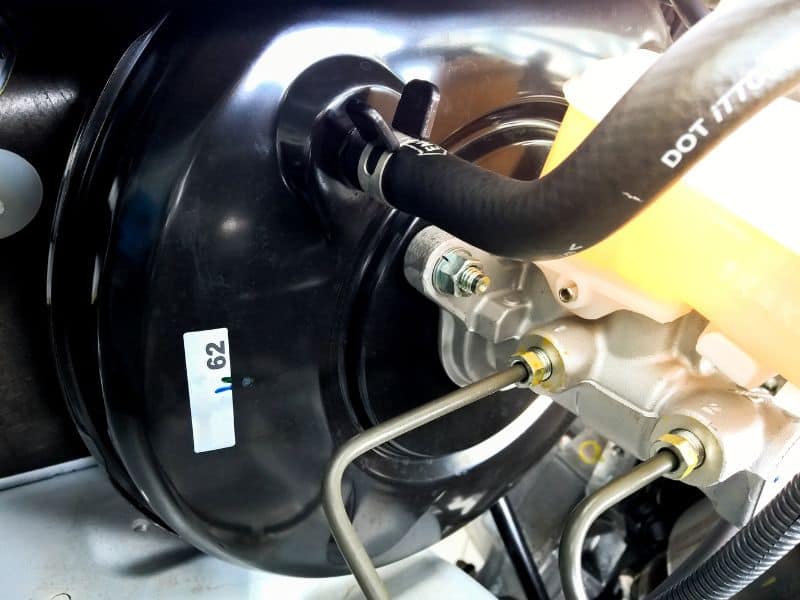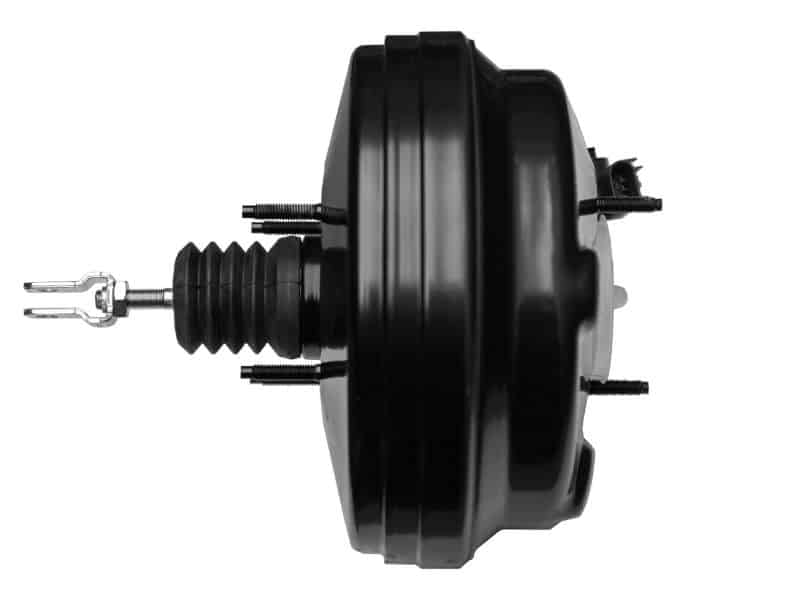Have you started feeling your vehicle’s braking performance degrade or your brake pedal becoming hard to press?
The symptoms of a bad brake booster are a hard brake pedal, longer braking distance, brake pedal not going to idle position, an engine misfire, engine running rough or stalling, check engine light, and a faint hissing sound.
I will discuss these seven bad brake booster symptoms in this article.

7 Bad Brake Booster Symptoms:
1. Brake Pedal Is Hard To Press Down
One of the first things you will experience is the brake pedal being much harder to press down than usual.
This is caused by two factors a hole or torn diaphragm inside the brake booster, taking away any vacuum assistance the engine could have provided.
The second reason can be that the vacuum hose from the engine or vacuum pump(on diesel and turbo vehicles) to the brake booster can be disconnected, bent closed, or have a hole or tear.
2. Longer Braking Distance
Since it is harder to press the brake pedal, the force applied to the brakes is also less, resulting in the vehicle taking a significant distance more to come to a halt.
So leave enough place between you and the vehicle in front and start braking much earlier for traffic lights and signs.
3. Brake Pedal Not Going To Idle Position
If you apply the brakes and release the brake pedal and it does not move up to its idle position, the spring inside the brake booster has failed.
The job of the spring is to ensure the brakes are entirely disengaged; otherwise, the brakes will constantly run on the discs or drum, which can cause the brakes to squeak when you don’t press the brake pedal and to ensure the pedal does not contact the brake light switch.
4. Engine Misfire
If the brake booster has a tear on the diaphragm or there is a tear in the vacuum line, this can cause unmetered air to enter the engine.
Since the engine is getting more air in without being measured by the MAF (Mass Air Flow Sensor), the engine will run lean and cause a misfire.
5. Engine Running Rough Or Stalling
While some engines won’t experience a misfire, the car can start running rough at idle and even wants to stall since there is unmetered air that the engine can’t compensate for.
Here is a very informative video about the symptoms of a bad brake booster:
6. Check Engine Light
With points four and five, if the vehicle is modern enough and picks up on the unmetered air entering the system, it will illuminate the check engine light on the instrument cluster.
7. Faint Hissing Sound
If there is a tear on the brake booster diaphragm when you press on the brakes when you are stationary and hold your head close to the dashboard, you might hear a slight hissing sound.
This sound is from air moving through the brake booster diaphragms tear; in modern vehicles, it will be tough to hear since the insulation is so good, but on a car made before the 2000’s you will be able to hear it.

Final Thoughts On Bad Brake Booster Symptoms
Of all the brake system failures, the brake booster isn’t that dangerous compared to a brake master cylinder failing where your pedal goes to the floor with no braking.
While it isn’t as dangerous, it is still advised to fix the problem as soon as possible because an emergency braking situation can happen to anyone at any time behind the wheel.
Hopefully, you found the article helpful on diagnosing bad brake booster symptoms.
FAQs
What Happens If A Brake Booster Loses Vacuum?
The brake pedal will become hard to press down, and your vehicle will take longer to come to a halt.
If the vacuum hose is connected to the engine, the engine will start idling rough and might want to stall or even misfire due to the unmetered air entering the engine.
How Do You Test A Brake Vacuum Booster?
To test the brake booster from behind the wheel, make sure the engine is off and press the brake pedal four times and on the fourth press, hold the brake down.
Now Start your vehicle; if the brake pedal moves toward the floor, the brake booster has no issues.
To test your check valve on the brake booster, let the car idle and depress the brake and keep it depressed.
Turn the vehicle off while the brake is depressed and wait; if the brake pedal is pushed up after 30 seconds, the check valve is fine; if it is pushed up before 30 seconds, the check valve is leaking.
What Does It Sound Like When Your Brake Booster Goes Out?
If the diaphragm inside the brake booster is damaged, you will hear a faint hissing sound when you apply the brakes.
This sound is generated from the air moving through the tear in the diaphragm.
Can A Brake Booster Cause A Soft Pedal?
No, a failing brake booster will result in a hard-to-press brake pedal.
What can cause a soft brake pedal is a brake master cylinder failing or too little brake fluid in the braking system.
What Is The Most Likely Cause When The Brake Pedal Feels Spongy?
Too little brake fluid in the system, and the brake master cylinder has already gulped in some air into the system.
Once there is air in the brake system, the brake pedal will feel spongy, and the only fix is to top up the brake fluid and rebleed the whole brake system.
